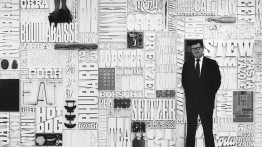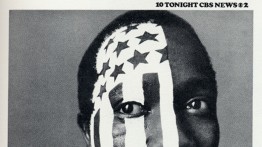Lou Dorfsman A’39
Louis “Lou” Dorfsman, a giant figure in corporate design, spent more than 40 years at the Columbia Broadcasting System (CBS) as vice president and creative director of advertising and design influencing all aspects of the network’s imagery—both its outward facing advertising and its in-house signage, stationery, elevators, even the company’s matchbooks. He was by all accounts a perfectionist who revolutionized advertising, taking it from text-heavy narratives to punchy, image-driven spots that conveyed ideas with wit and speed—plus a brilliant deployment of typography.
Dorfsman, who graduated from The Cooper Union in 1939, served in the army and took a variety of design jobs including making displays for the 1939 World’s Fair before landing at CBS in 1946 as an art director. He thrived at CBS. After the sudden death of William Golden, CBS’s creative director responsible for the company’s iconic eye logo, he continued and extended the design language Golden had implemented but injected it with a fearless aesthetic that suited the boldness of the era.
In his obituary of Dorfsman in The New York Times, the designer Steven Heller, wrote, “At CBS, Mr. Dorfsman injected a rare social urgency into some of his best advertisements for the network’s public affairs programming. The full-page newspaper ad for “Of Black America,” the first network series on black history, showed a black man in black and white, with half his face painted with the stars and stripes of the United States flag, and with his eyes focused intently on the viewer; the image became a virtual emblem for race relations.”
When CBS commissioned its famed Eero Saarinen–designed headquarters, Dorfsman not only designed many aspects of its interior, he also created an outdoor exhibition about the company’s history while the granite-clad building, dubbed Black Rock, was under construction. He transformed what would’ve been a dreary building site into a real time advertisement for CBS, touting the storied broadcast history behind the company’s nickname, the Tiffany Network.
In Black Rock’s corporate cafeteria he created the “gastrotypograhical assemblage,” a three-dimensional collage of words and images related to eating, kitchen utensils, and all kinds of food. A former president of the network, Frank Stanton, donated $1 million to The Cooper Union in honor of Dorfsman and his wife Ann Hysa Dorfsman, who was also a 1939 graduate of the School of Art.
Dorfsman regularly hosted office visits for students from The Cooper Union’s graphic design classes and served as member of the college’s Board of Trustees for almost three decades. He also acted as chair of a design committee that created the Herb Lubalin Study Center of Design and Typography, where his entire archive remains housed.
Heller reflected on Dorfsman’s huge impact on the network where he made his career. “The cleverness and subtle beauty of his advertisements were credited with winning over many viewers to both news and entertainment programs on the network.”







